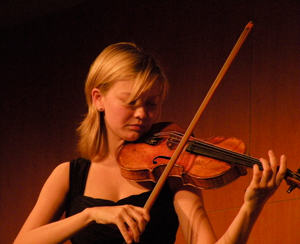by Daniel Hathaway

Play “drop the needle” on the seventh symphony (an archaic reference to vinyl recordings) and you could imagine that long stretches of music were the work of a British composer writing in the pastoral mode. Mena shaped a tasteful performance of the one-movement work that paid close attention to the dialogues between winds and strings. Genial and satisfying, the performance only lacked enough surface tension to sustain its long, continuous narrative.
Playing assertively and exploring both the softest and loudest extremes of the violin, Ibragimova brought her native Russian temperament to the concerto. That large-scale approach allowed the piece to overflow its banks on several occasions with outsized tuttis — excesses that Mena seemed lured into creating but needed to rein in. It also led the soloist to produce some ungainly sounds in the third movement — passages where she also glossed over many of the notes. The finale (referred to by one British commentator as a “polonaise for polar bears”) also needed more rhythmic stability.
The audience seemed not to mind any of that, bestowing a resounding ovation on the soloist. Ibragimova showed a completely different side of her personality with her encore, a Bach sarabande. Here, she was all sweetness and restraint. It was lovely, but as in the concerto, her softest playing needed more support and presence in a hall the size of Severance.
The stage was packed with musicians after intermission for Arnold Schoenberg’s Peleas and Melisande, a turn-of-the-twentieth-century score that calls for an eight-pack of horns, pairs of English horns, bass clarinets and harps, and five trombones (including an alto model), in addition to triple winds and strings.
Mild of manner and efficient of baton, Juanjo Mena led The Cleveland Orchestra in a lustrous and well-paced excursion through Schoenberg’s score, terracing its climaxes and relaxing its pace to let dozens of lyrical solos shine through.
Another strong candidate for projected supertitles, Peleas and Melisande spins an eventful narrative in four scenes during its 40-minute course. Sometimes it was difficult to relate the music to the scenario, but that’s hardly a problem with a score so arresting. It’s like an extravagant Richard Strauss tone poem, but with a bit more intellectual restraint. You have to wonder what might have been next for Schoenberg, had he not taken so drastic a shift in direction. It was wonderful to hear it on Thursday.
Published on ClevelandClassical.com February 17, 2015.
Click here for a printable copy of this article




